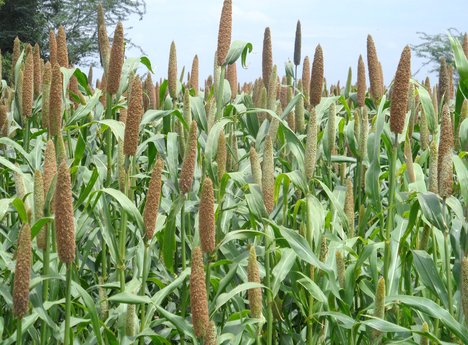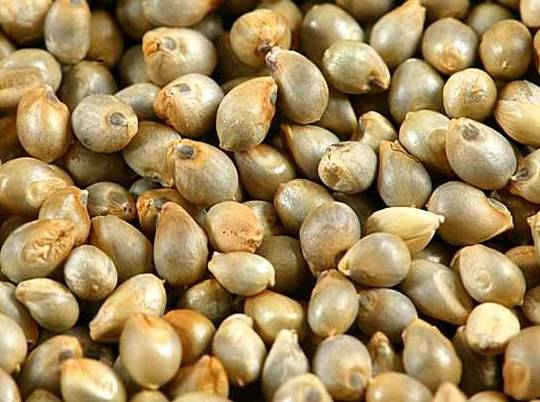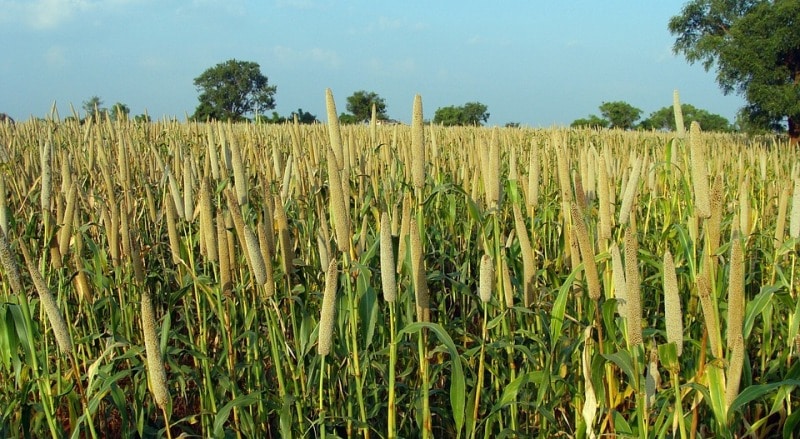A step by step guide for Bajra cultivation/Pearl Millet farming
Today, we explain Bajra cultivation practices along with the seed rate of Bajara, Sowing methods, Bajra crop care along with intercultural operations.

Introduction of Bajra:
Bajra is popularly known as “pearl millet” and belongs to the family of Gramineae. This grain is basically originated from India or Africa. Bajra is a coarse grain crop and considered to be the poor man’s staple nourishment and suitable to cultivate in drylands. Major Bajra production states in India are Rajasthan, Maharashtra, Haryana, Uttar Pradesh, and Gujarat. Bajra can also be used as valuable animal fodder. It is one of the major crops of China, India, South-Eastern Asia, Sudan, Pakistan, Arabia, Russia & Nigeria.
Major Bajra production states in India:
Top Bajra producing state is Rajasthan followed by Maharashtra, Haryana, Gujarat and Uttar Pradesh. The top high yielding state is Tamil Nadu.
Health benefits of Bajra or Pearl Millet:
Some of the health benefits of Bajra are given below.
- Bajra is very good source of energy.
- Bajra promotes heart health.
- Bajra helps in reducing weight.
- Bajra helps in digestion disorders.
- Bajra may help in preventing cancer.
- Bajra controls blood sugar levels and hence good for the diabetic.
Local names of Bajra in India:
Pearl Millet (English), Bajra (Hindi,Urdu,Panjabi),Sajje (Kannada), Kambu (Tamil), Kambam (Malayalam), Sajjalu (Telugu), and Bajri (Rajasthani, Gujarati and Marathi).
You may also like Cucumber Farming Profit, Cultivation Cost, Project Report.
Commercial hybrid varieties of Bajra in India:
ICM4-155,VBH-4,NBH-149,MH-306,NH-338,MP-204, and MP-205.
The agro-climatic requirement for Bajra cultivation:
Bajra grows well in dry and warm climatic conditions and it’s drought-tolerant crop which requires low annual rainfall ranging between 40 cm to 60 cm. The ideal temperature for Bajra cultivation is between 20 °C to 30 °C. Moist weather is advantageous during its vegetative growth. In North India, Bajra is grown as Kharif crop and in some southern parts is grown as summer crop providing Irrigation.
Soil requirement for Bajra crop plantation:
Bajra can be grown in a wide range of soils. However, It thrives best in black cotton soils, sandy loam soils having good drainage. This crop does not prefer acidic and waterlogging soils. Avoid saturated soils for its cultivation. It grows successfully well in soils with low pH (or) high salinity. Bajra can be easily grown in regions where other cereal crops like wheat or maize would not survive.
The field preparation for Bajra sowing:
2 to 3 harrowing followed by a plowing is required to make the soil in the field to the fine tilth. Any weeds should be destroyed during the field preparation to accommodate proper sowing and distribution of seed at an appropriate depth.
The seed treatment of Bajra:
The organic mercurial compound Ceresan, Agrosan should be used @ 2 – 3 kg per hectare to control seed-borne diseases.

You may also check the Biogas Production Process.
The seed rate and spacing of Bajra plants:
Seed rate and spacing in Bajra cultivation as follows:
- 3 to 3.5 kg/ha for dibbling method.
- 5 to 5 kg/ha for the drilling method.
Row spacing of 40 cm to 45 cm should be maintained and within rows, 10 cm – 15 cm should be kept.
Best time to sow the Bajra seeds:
Ideal time for Bajra sowing time is middle to last week of July month.
Weed control and Intercultural Operations of Bajra crop:

Gap filling or Thinning is followed, Applying Atrazine @ 0.5 kg/ha works well to control weeds.
Manures and Fertilizer requirement of Bajara crop:
Even Bajra requires fewer nutrients If you are cultivating commercial hybrid Bajra, adding Farm Yard Manure (F.M.Y) or Compost result in better yield and quality of seed. Apply these organic manures at the time of soil or land preparation so that soil will become fully decomposed by the time of sowing. 90 –100 kg of N: 50-60 kg of P: 50-60 kg of K is recommended for hybrid variety.
Fertilizers should be applied in split doses. At the time of sowing, full phosphorus and potash and half of the nitrogen should be added as basal application. 1/4th nitrogen should be added after 30 and 60 days (after sowing).
Pests, diseases, and control of Bajra:
Grasshoppers and stem bores are major pests in Bajra cultivation. These can be controlled by dusting the crop with BHC 5 % (or) 2 sprayings with 2 liters of Eldrin 20 c.c. The main disease in Bajra farming is “Downy mildew” , to control this disease, treat the seeds with a fungicide like M-45 @ 2.0kg/ha (or) Dithane Z-78 in 900 -1000 liters of water.
You may be interested in Organic Fruit Farming, Business Plan.
Harvesting Procedure and threshing of Bajra crop:
The crop is ready for harvesting when the grain become hardy & contain moisture. Two methods can be followed in harvesting Bajra crop: Cutting earhead or cutting of entire plants by sticks. stalk the cut plants for 4 to 5 days in the sun for drying grains. Grains can be separated by beating the earheads.
The yield of Bajra:
Rainfed crop yields about 12 to 16 quintals/ha and irrigated crop yields about 25 to 35 quintals/ha. The yield also depends on the soil type, variety, season, and cultivation practices.
You may be interested in Growing Garlic; Planting; Care; Harvesting.
How can I grow Bajra in summer( February orMarch to May or June )
What is the best time to bajra farming in borsad taluka gujarat during rainy season ?